How to Install SSD in PS5: A Comprehensive Guide
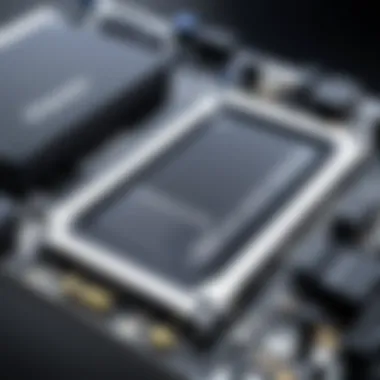
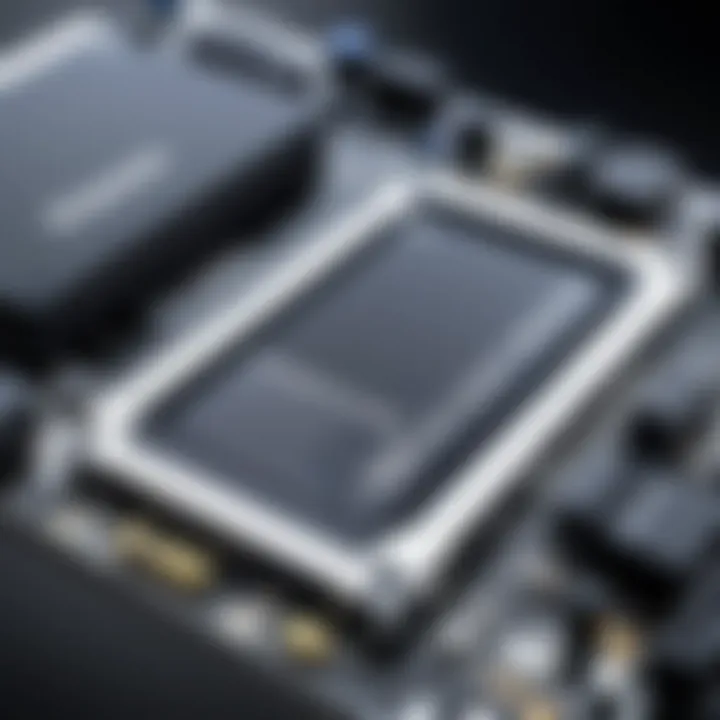
Intro
Installing an SSD in a PlayStation 5 (PS5) can significantly improve both performance and storage capacity. As games become increasingly resource-intensive, managing load times and available storage has become essential for an optimized gaming experience. This guide will walk you through the process of selecting a compatible SSD, the tools needed for installation, the step-by-step installation process, and how to configure your console settings afterward. Additionally, we will cover common troubleshooting issues and respond to frequently asked questions.
By following this comprehensive guide, gamers can expect not only a faster gaming experience but also an enhancement of their overall console functionality.
Key Features
When considering an SSD upgrade, it is crucial to understand the key features that impact performance and usability. Here are some important aspects to consider:
- Speed: SSDs dramatically reduce load times, particularly for large, open-world games with extensive data.
- Storage Capacity: With games nearing 100GB or more, expanding storage helps ensure you will not need to frequently uninstall titles.
- Design and Build Quality: A good SSD should have a robust design. Look for models with heat sinks or those that manage thermal performance effectively to prevent overheating during intense gaming sessions.
Product Specifications
Before purchasing an SSD, pay attention to specifications. Here are some key factors:
- Technical Specifications: Look for NVMe SSDs that utilize PCIe Gen 4 technology for optimal performance. These include read and write speeds that can exceed 5000 MB/s, significantly faster than traditional hard drives.
- Compatibility and Connectivity: Ensure the SSD is compatible with PS5’s M.2 interface. Sony outlines specific requirements for SSDs, including size (2230 form factor recommended), speed, and functionality with the PS5 architecture.
"Selecting the right SSD is vital for maximizing the capabilities of your PS5. Compatibility is the first step to a successful installation."
In summary, upgrading your PS5 with an SSD can lead to a seamless gaming experience by enhancing load times and providing ample storage. The next sections will further detail the selection process, installation steps, and configuration settings necessary for a smooth installation.
Foreword to SSD in PS5
The PlayStation 5 is a powerful gaming console that promises high performance and rapid load times. However, as games become larger and more complex, the need for expanded storage is increasingly crucial. Installing a solid-state drive (SSD) in your PS5 not only addresses storage limitations but also enhances the overall gaming experience.
An SSD can dramatically improve load times, allowing gamers to spend less time waiting and more time playing. This is particularly important in a gaming world where every second counts. Additionally, the PS5's architecture is designed to leverage the speed of SSDs, offering an advantage over the traditional hard drives that many players may still be using. This guide will take you through the essentials of installing an SSD in your PS5—emphasizing its importance and implications for performance.
Understanding the Need for Expanded Storage
As game sizes grow, the internal storage of the PS5 can fill up quickly. Gamers often find themselves faced with difficult choices about which games to keep or delete. This limitation can be frustrating and hinder the enjoyment of the console. Adding an SSD not only alleviates this issue by providing additional space but also allows for greater flexibility. You can download and install multiple games without the continual cycle of deleting and reinstalling, thus enriching the overall gaming library.
Benefits of SSD over Traditional Hard Drives
Solid-state drives offer numerous advantages over traditional hard drives, particularly in a gaming context. Key benefits include:
- Speed: SSDs have significantly faster read and write speeds compared to traditional hard drives. This results in quicker game launches and minimal loading screens.
- Durability: Without moving parts, SSDs are less prone to physical damage. This can result in a longer lifespan and reliability under various conditions.
- Energy Efficiency: SSDs consume less power, which can lead to less heat generation and quieter operation. This is especially beneficial for console performance and lifespan.
These factors make the installation of an SSD a strategic enhancement for any serious PS5 gamer.
Selecting the Right SSD for PS5
Selecting the right SSD is critical for maximizing the potential of your PlayStation 5. The console's architecture is designed to work seamlessly with high-speed storage solutions, making it vital to choose a compatible SSD. Choosing a suitable SSD ensures that you will benefit from faster load times and increased capacity. This section delves into compatibility requirements, examines performance specifications, and suggests several models that meet the PS5's needs.
Compatibility Requirements
When selecting an SSD for your PS5, ensuring compatibility is the first step. PlayStation 5 has specific requirements for SSDs due to the unique architecture of its storage system. Not every SSD will work with the console. An SSD must meet certain dimensions and support the PCIe 4.0 interface.
The PS5 accommodates M.2 2230, 2242, and 2280 form factors, which refer to the length and width of the SSD. Moreover, the SSD should have a minimum read speed of 5,500 MB/s to match the console's performance. This is essential for running games smoothly and quickly loading content.
Analyzing Performance Specifications
Performance specifications are fundamental when it comes to choosing an SSD for your PS5. Not only will these specifications dictate how well the games perform, but they will also reflect load times and overall user experience. Here is a closer look at the three primary performance specifications of SSDs:
Read Speeds
Read speeds represent how quickly data can be retrieved from the SSD. For PS5, having a high read speed is essential because it directly affects the loading times of games and applications. A fast read speed reduces latency and improves gaming immersion. A characteristic of high-performance SSDs is achieving speeds exceeding the minimum requirement of 5,500 MB/s.
Another unique feature of read speeds is that they influence how efficiently games load textures and assets. If a game requires frequent access to data, an SSD with faster read capabilities enhances performance. However, keep in mind that while higher read speeds improve performance, they can also come at a premium cost.
Write Speeds
Write speeds indicate how quickly data can be stored onto the SSD. Just like read speeds, the write performance of an SSD is crucial for a good gaming experience. Higher write speeds allow for faster installations, updates, and data transfers. Effective write speeds help in saving game progress without noticeable delays, which can be frustrating during intense gameplay sessions.
Typically, many SSDs optimize read speeds while compromising on write speeds. However, look for SSDs that maintain a balance between these two metrics. An SSD with strong write speeds will be beneficial in maintaining consistent performance across multiple tasks, such as downloading, installing, and playing games.
Thermal Management
Thermal management in SSDs is another important aspect. As SSDs operate, they can generate significant heat, which can lead to throttling—where the SSD reduces performance to prevent overheating. Therefore, selecting an SSD with effective thermal management solutions is key.
Many SSDs come with built-in heat sinks or thermal pads. These features help dissipate heat more effectively, ensuring that the drive can maintain peak performance without overheating. Understanding the thermal aspects of an SSD ensures longevity and reliability during heavy gaming sessions.

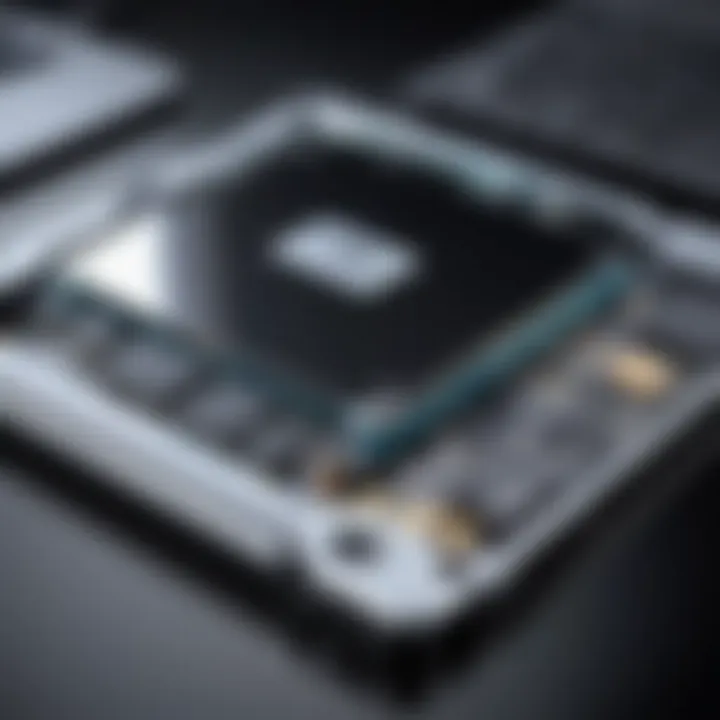
Recommended SSD Models
Once you have an understanding of compatibility and performance specifications, it's time to consider some recommended SSD models that work well with the PS5. Noteworthy brands like Samsung, Western Digital, and Seagate provide SSDs that fit the PS5's requirements.
- Samsung 980 Pro: Known for its excellent read and write speeds, and optimized thermal performance.
- Western Digital Black SN850: Another high-performance option, this SSD is well-regarded for its compatibility with gaming consoles.
- Seagate FireCuda 530: Offers high capacity and exceptional read/write performance.
These models provide a range of choices regarding capacity and price, allowing every user to find a suitable match for their gaming needs. When selecting your SSD, ensure to review compatibility, performance features, and thermal management closely.
Gathering Necessary Tools for Installation
Gathering the right tools is a crucial step before you start the SSD installation process in your PS5. Having the appropriate tools ensures that the installation goes smoothly and safely. It minimizes the risk of damaging the console or the new SSD. In this section, we will discuss the tools you need, their importance, and how they contribute to a successful installation.
List of Required Tools
Before diving into the installation, here is a list of the essential tools you will need:
- Screwdriver
- Anti-Static Wrist Strap
- Soft Cloth or Surface
Screwdriver
A proper screwdriver is indispensable for removing the screws from your PS5. The most significant aspect is that it should fit the screws securely, avoiding any stripping. A Phillips-head screwdriver is typically required for the PS5.
The key characteristic of a good screwdriver is its grip. This allows for better torque when unscrewing or screwing in. A popular choice among users is a magnetic screwdriver, as it holds screws in place, making it easier to work with.
Tip: Ensure the screwdriver is of sufficient length to reach all screws in the console.
Advantages of using a quality screwdriver include ease of use and reduced potential for damaging screws. On the downside, poor-quality screwdrivers can strip screws or slip, causing unnecessary damage.
Anti-Static Wrist Strap
An Anti-Static Wrist Strap is essential to protect both the hardware and your new SSD. The specific aspect of this tool is its ability to ground the user, preventing the buildup of static electricity.
This strap connects to a grounded surface, discharging any static electricity that may damage sensitive components. It is a beneficial choice since many electronic components are vulnerable to static discharge.
One advantage is its simplicity; wearing the strap ensures immediate protection. The only downside is that some might find it uncomfortable during extended use.
Soft Cloth or Surface
Finally, a soft cloth or cushioned surface is important for your work area. It helps to prevent scratches or damage to your PS5 and the new SSD. When you open your console, placing it on a soft surface decreases the chances of accidental dents or scratches.
The key characteristic of a soft cloth is that it provides a gentle barrier between the console and hard surfaces. A popular choice is a microfiber cloth because of its durability and softness.
Using a soft surface has the advantage of protecting delicate components, but you should ensure it is clean to avoid dust buildup, which can be harmful to sensitive parts.
Preparing PS5 for SSD Installation
Getting your PlayStation 5 ready for SSD installation is an essential step in the overall process. This stage ensures that your console is in the right state for a smooth installation. Proper preparation not only safeguards your data but also allows the installation process to unfold without complications. The importance of this phase cannot be overstated. It sets the foundation for enhancing your gaming experience by minimizing the chances of interruptions or technical issues during installation.
Backing Up Important Data
Before you proceed with the SSD installation, it is critical to back up any important data stored on your PS5. While the installation process typically should not affect your existing data, accidents can happen. A backup serves as a safety net to protect your saved files, game data, and downloaded content from potential unforeseen mishaps.
To back up your data, follow these steps:
- Navigate to the Settings menu on your PS5 home screen.
- Select System followed by Backup and Restore.
- Choose Back Up Your PS5 and follow the prompts.
- Decide which data you want to save and begin the backup process.
This backup can take some time, depending on the amount of data. Ensure your console is connected to a stable power source during this process.
Shutting Down and Unplugging the Console
Once your data is secure, the next step is to properly shut down and unplug your PS5. This is crucial to avoid any risk of electrical shock or damage during the physical installation of the SSD.
- Press the PlayStation button on your controller to access the control center.
- Select Power, then choose Turn Off PS5. Avoid using the Rest Mode option to ensure complete shutdown.
- Once the console is off, unplug all cables, including the power cable, to eliminate any electrical source.
- Wait at least a few minutes before proceeding.
Following these steps will help ensure a safe environment for installing your new SSD. After this preparation phase, you are better positioned to move onto the actual installation process without any unnecessary concerns.
Steps to Install SSD in PS5
Installing an SSD in a PlayStation 5 is imperative for upgrading storage capacity and enhancing performance. As games grow larger and more demanding, having adequate storage is crucial. This section will detail the necessary steps for effective SSD installation, emphasizing how proper execution can lead to significantly improved load times and overall gaming experiences.
Opening the PS5 Console
Removing the Faceplate
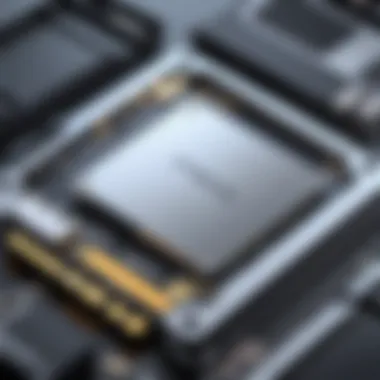
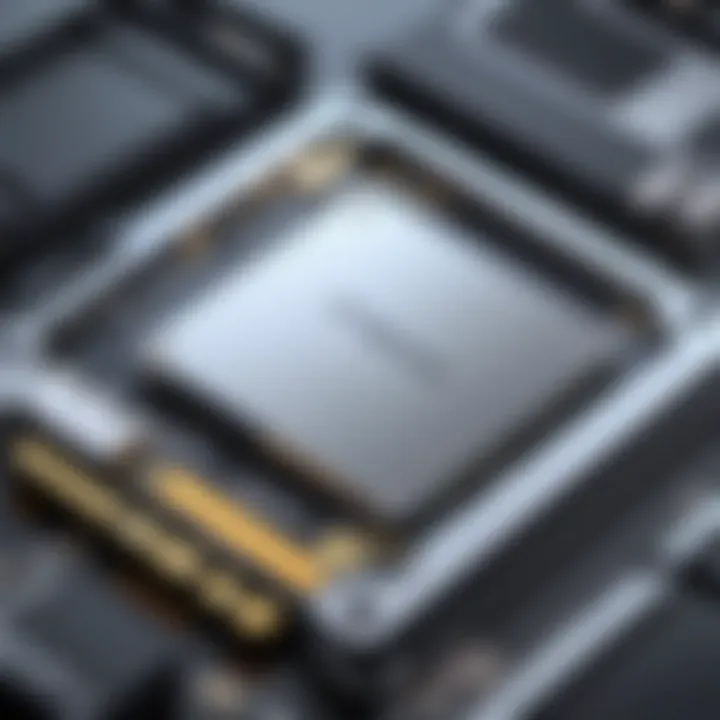
The process of removing the faceplate involves a careful approach, as it protects the internal components of the PS5. This faceplate is significant because it provides both aesthetics and functionality. Its removal allows access to the SSD slot necessary for installation.
A key characteristic of this step is that it requires minimal tools, usually just a gentle pull at designated areas. This method makes it a beneficial choice as it does not risk damaging the console. However, users must follow specific instructions to avoid scratches. Its unique feature lies in the ease of access it provides to the internal hardware, allowing for straightforward upgrades without extensive disassembly.
Locating the SSD Slot
Finding the exact location of the SSD slot is essential for a successful installation. This slot is specifically designed for SSDs that meet the PS5's compatibility requirements. Its accessibility facilitates quick installation and is a key aspect for users who may not be tech-savvy.
Notably, the SSD slot's distinct positioning is in the middle section of the console. This location is advantageous as it permits easy installation without the need for navigating through cluttered components. Users must take care not to overlook this step to ensure proper installation.
Inserting the SSD
Aligning the SSD Correctly
Correct alignment of the SSD ensures it fits securely in the slot, preventing issues later on. This step is critical because improper alignment can lead to difficulties in detecting the SSD by the PS5. Therefore, users must pay attention to the guides within the slot which assist in achieving the right orientation.
A notable characteristic is that most SSDs have a notch that aligns with the guides in the slot. This makes aligning easier, thus reducing the chances of mistakes during installation. Correctly aligning the SSD is a popular choice because it minimizes potential frustrations associated with installation. Improper alignment, on the other hand, can lead to the SSD not seating correctly, which may cause problems.
Securing the SSD with Screws
Once the SSD is properly aligned, it is crucial to secure it tightly with screws. This step strengthens the connection between the SSD and the console, ensuring stability during operation. The screws prevent the SSD from moving and possibly becoming loose over time, which is vital for maintaining performance.
The use of screws here is advantageous as it provides a solid hold without excessive pressure on the SSD. This feature enhances the durability of the installation and is a common practice among tech enthusiasts. Lack of proper securing can lead to potential performance drops, so explicit attention to this step is essential.
Reassembling the PS5
Replacing the Faceplate
After inserting and securing the SSD, replacing the faceplate is a straightforward yet important step. This process protects the newly installed hardware and restores the console's aesthetic appearance. Properly replacing the faceplate ensures that the internal components remain securely seated and free from dust or debris.
A key characteristic of this step is that it provides closure to the installation process, signifying readiness for use. It helps re-establish the same level of protection the console originally had. An advantage is that the design of the faceplate allows for easy reattachment without needing special tools, making it a user-friendly choice.
Final Checks
Conducting final checks after the installation is necessary to ensure everything functions as intended. This includes verifying that the faceplate is secure, checking SSD seating, and ensuring the console powers on successfully. These final checks can prevent future complications and help users verify successful installation.
A crucial aspect of this process is ensuring that all connections are secure. This helps in avoiding potential malfunctions in the future. Carrying out these checks serves as a precautionary measure, ensuring that the system runs smoothly. Skipping these might lead to overlooked mistakes that could hinder the overall performance of the PS5.
Configuring PS5 Settings Post Installation
After installing the SSD in your PlayStation 5, the process is not complete. You need to configure specific settings to ensure that the console recognizes and utilizes the new storage effectively. This step is crucial for maximizing the performance benefits the SSD can provide, including quicker load times and efficient storage management. Therefore, it is important to execute the following tasks carefully to optimize your gaming experience.
Updating the PS5 System Software
Before you can use your newly installed SSD, it is essential to ensure that your PS5 system software is up to date. This update may include various optimizations and fixes that can directly affect the functionality of the SSD. The PlayStation 5 is continuously receiving updates that improve its compatibility with newer hardware, including SSDs. To update the system software:
- Go to the Settings menu from the home screen.
- Scroll down to System Software and select it.
- Choose System Software Update and Settings.
- Select Update System Software.
- If an update is available, follow the on-screen instructions to download and install it.
Regularly updating your PS5 not only helps in keeping it secure but also enhances performance and stability when utilizing additional storage. This attention to detail avoids potential issues down the line and ensures that you get the most out of your system.
Formatting the New SSD
After ensuring that the system software is current, the next step is formatting the new SSD. Formatting is crucial as it prepares the SSD for use by the PS5, establishing a file structure that the console can recognize. Without this step, you may encounter issues in accessing or storing games and applications. Here’s how to format your new SSD:
- Navigate to Settings on the home screen.
- Scroll to Storage and select it.
- Choose M.2 SSD Storage to see the newly installed SSD.
- If prompted, select Format as Extended Storage.
- Follow the on-screen instructions to complete the formatting process.
This function is vital because it optimizes the performance of your SSD and ensures seamless integration with the PS5's existing storage system.
Keep in Mind: Formatting the SSD will erase all data on it, so ensure it is new or contains no important information before proceeding.
By following these steps, you not only ensure that the PS5 recognizes the new SSD but also enhance the overall gaming experience you can expect from this hardware upgrade.
Testing the New SSD
After the installation of the SSD in your PS5, it is critical to conduct tests to ensure its performance and functionality. Verifying your new drive not only confirms that the installation was successful but also provides insight into how the SSD impacts the overall gaming experience. This section outlines the necessary steps to evaluate load times and storage capacity, giving a comprehensive understanding of the effectiveness of your SSD upgrade.
Evaluating Load Times
One of the most significant benefits of adding an SSD to your PS5 is the enhancement in load times. Load times directly affect how quickly games boot and levels load. To evaluate these improvements, you should conduct a series of tests using both your old storage and the new SSD.
First, note the load times of a few selected games before the SSD installation. This can be done using an external stopwatch or even a smartphone timer. Next, perform the same tests on the SSD. Comparison of the recorded times will indicate the upgrade's effectiveness. Here are some steps to follow:

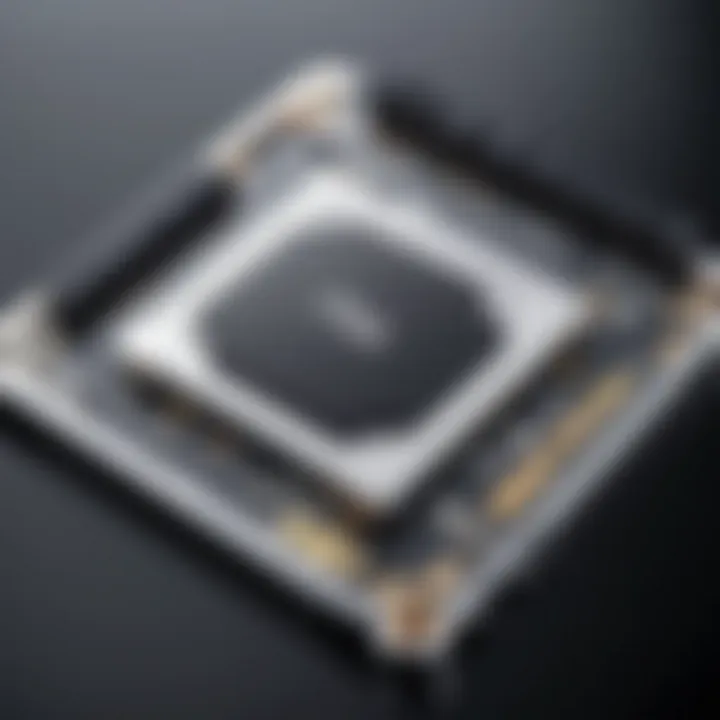
- Select games that are typically known for longer load times.
- Record the time it takes to start the game from the dashboard to the initial gameplay.
- Repeat the process after SSD installation using the same titles and record the times again.
A noticeable decrease in load times confirms that the SSD has significantly improved your gaming experience. If load times do not improve as expected, it may indicate installation issues or compatibility problems.
Checking Storage Capacity
The next crucial step after installing an SSD is to verify its storage capacity. The PS5 is known to support SSDs with specific capacities to improve performance and ensure a seamless experience. Confirming that your new SSD is recognized and fully operational involves checking its listed storage capacity in your console settings.
Here’s a simple process to check storage capacity:
- Navigate to Settings in the PS5 menu.
- Select Storage. Here, you will see the total available space listed.
- Compare this to the stated capacity of the SSD you installed. It should closely match, barring any space taken by the system itself.
If the storage capacity shows less than expected, it may require troubleshooting steps to ensure the drive is functioning correctly. Overall, confirming the storage capacity allows users to understand how much data they can store and manage going forward.
"Testing load times and storage capacity is paramount after the installation of an SSD to maximize gaming efficiency."
Taking time to thoroughly assess both load times and storage capacity will undoubtedly provide a wealth of information about the SSD's impact on the PS5. These evaluations not only highlight the benefits of the upgrade but can also uncover potential issues that could hinder performance.
Troubleshooting Common Issues
Troubleshooting common issues encountered during the SSD installation in a PlayStation 5 is a significant part of the process. Understanding potential problems helps ensure that users can effectively resolve concerns that may arise. This section aims to guide users through issues that may disrupt a smooth setup, leading to an overall enhanced gaming experience. By addressing these common hurdles, users can sustain their engagement without interruptions, easily returning to their favorite games.
SSD Not Detected
One of the most common issues users face after SSD installation is the drive not being detected by the PS5. This particular problem can arise for several reasons.
To rectify this situation, users should first ensure that the SSD is securely installed. If the disk is not properly seated in its slot, the console will not recognize it. Open the PS5 and check the SSD connection, ensuring it aligns correctly and is fastened securely with screws.
Another factor to consider is compatibility. Not all SSD models qualify for installation in the PS5. Double-checking specifications against Sony's list of supported SSDs is a vital step. If the SSD fails to meet required performance metrics, the console will ignore it. In addition, ensuring the PS5’s system firmware is updated is crucial. An outdated system can lead to detection issues. Users should check for updates in settings and apply them as necessary.
Should these steps not remedy the situation, try testing the SSD on another compatible system. This step will help identify if the problem lies with the SSD itself or if it is compatibility-related with the PS5.
Performance Issues
After successfully installing the SSD, users might still encounter performance-related issues. These can manifest as slower loading times, stuttering in gameplay, or erratic data transfer speeds. Understanding the source of these problems is essential for effective troubleshooting.
Firstly, similar to detection issues, performance bottlenecks may relate to compatibility. Make sure the selected SSD meets the PS5's minimum specifications. It must offer adequate read and write speeds, as outlined by Sony. If the drive does not meet these specifications, users may experience suboptimal performance.
Thermal throttling is another critical point to consider. Some SSDs can overheat if not appropriately equipped with heatsinks. When the drive overheats, performance can decline significantly. Ensuring that the installation includes an adequate thermal solution can mitigate this issue.
Additionally, formatting issues can affect the SSD's performance. Ensure to format the SSD through the PS5’s system settings post-installation. This ensures the console configures it correctly, maximizing efficiency.
Lastly, users might consider checking for updates for added games. Sometimes, performance issues may not relate to the SSD but rather outdated game files that need optimization. Keeping all components up to date will improve overall gaming performance.
"Always ensure compatibility and adequate cooling solutions to enjoy performance benefits of SSD upgrades.”
By addressing these common problems proactively, users can avoid significant disruptions and enjoy the rich, uninterrupted gaming experience that enhanced storage delivers.
Frequently Asked Questions
In this section, we address some of the most common inquiries regarding the installation of SSDs in the PlayStation 5. This segment is crucial because it helps demystify the process and clarifies concerns that many users may have. Frequently asked questions serve as an essential resource, providing insights and solutions to potential problems. Understanding these aspects can lead to a smoother installation experience and better usage of the PS5's expanded storage capabilities.
Can Any SSD Be Used?
Not all SSDs are suitable for the PS5. The console requires an M.2 NVMe SSD that meets specific performance and size requirements. First, you need to ensure the SSD is compatible with PCIe Gen 4 and has a sequential read speed of at least 5,500 MB/s. Additionally, SSDs should be in a size range from 250 GB to a maximum of 4 TB. Before buying an SSD, always check the Sony compatibility list to avoid any mismatch.
What are the Risks of Installing an SSD?
While adding an SSD to your PS5 can significantly enhance performance, there are varied risks involved. The primary concern is that improper installation can lead to hardware damage. If you use a non-compatible SSD, you might experience overheating issues or system failure. Additionally, users may void their warranty if they open the console without taking proper precautions. Always read the manufacturer's instructions and ensure the SSD meets all requirements to minimize these risks.
Will SSD Affect Game Performance?
Yes, using an SSD can improve game performance significantly. SSDs generally provide faster load times compared to traditional hard drives. This means that games load quicker, and transitioning between different game areas becomes smoother. However, the extent of performance enhancement also depends on the specific game and its design. Some games are optimized for SSD speeds, while others may not showcase noticeable differences. Nonetheless, the overall gaming experience typically improves when using a correctly installed and compatible SSD.
The End on SSD Installation for PS5
Installing an SSD in the PlayStation 5 opens the door to an enhanced gaming experience, offering significant benefits that extend beyond just increased storage. This article has explored various facets of the installation process, emphasizing the essential need for quality storage solutions in a gaming console that offers high-performance capabilities.
The key elements discussed include the selection of compatible SSDs, the necessary tools for the installation, and the steps involved in both the physical installation and post-installation configuration of the console. Furthermore, we addressed common issues that might arise during or after installation, equipping readers with troubleshooting techniques essential for maintaining peak performance.
It's crucial to remember that a well-installed SSD not only improves load times but also provides a more seamless gaming experience. With growing game sizes and more sophisticated graphics, relying solely on the internal storage of a PS5 may not be sufficient moving forward. An upgrade can be viewed as a long-term investment into gaming quality, especially for users who intend to keep their consoles for many years.
In summary, having a solid understanding of the SSD installation process and its implications can empower gamers to optimize their PS5 systems effectively. This guide serves as a foundation for making informed decisions regarding storage solutions, ensuring that the PS5 remains competitive with evolving game demands and performance expectations.
Recap of Key Points
- Importance of SSD Upgrade: Enhances overall gaming performance through faster load times.
- Compatibility Matters: Not all SSDs are suitable for PS5; follow specifications outlined in this guide.
- Installation Essentials: Required tools and careful procedure contribute to a successful SSD installation.
- Post-Installation Configuration: Proper setup ensures the new SSD integrates smoothly with existing systems.
- Troubleshooting Awareness: Knowing common issues and their solutions can save time and frustration post-installation.
"Upgrading to an SSD can redefine your gaming experience, allowing for more immersive play and quicker transitions between activities."



